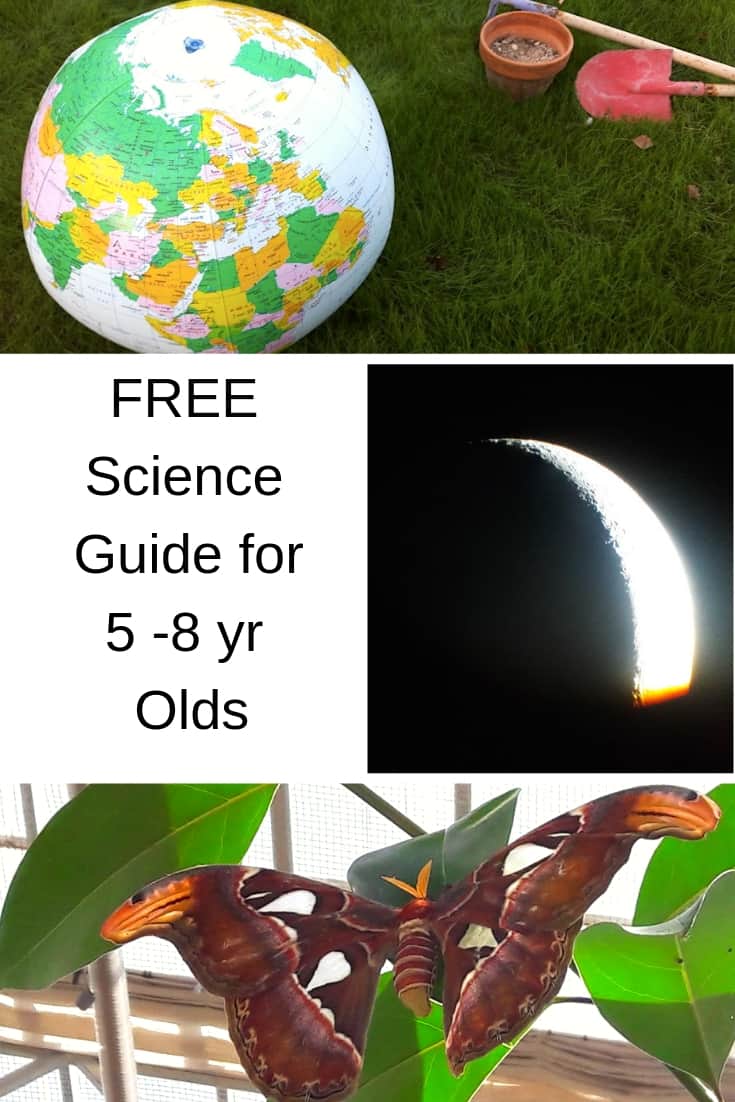
Ideally you start off these lessons in August and you have Lesson 6 -Winter Solstice Party on Winter Solstice, around Dec 21st. Lesson 12 should be on December of the following year.
Follow up with Natural Science Guide for 8 – 11 year olds.
This guide is progressive. That’s why it starts with Lesson 1. However, you can come back to the same lesson over and over every year until the concepts and vocabulary are grounded.
Also, these lessons don’t have a set time frame. The activities and core lesson can be done in one day but the concept can and should come up again and again for a few weeks until you can move on to the next lesson.
Please note that this is not a teach-as-you-read curriculum. It is a guide and you do have to prepare ahead of time. The lessons are very simple so there is only a few sentences to memorize…keep a couple of flashcards with you. Do plan and get supplies ahead for the crafts, activities, and meals.
Important note: This can be a guide for a homeschool co-op or learning group with a little group of kids.
Lesson 1
Start with the song Big Beautiful Planet by Raffi.
Read the book Our Big Home, An Earth Poem
Core lesson – Earth Spinning on its Axis. Take a globe, I like this inflatable one and spin it to show that the Earth spins. Point out the word “axis”
Talk about the Sun rising and setting. Explain that the Sun doesn’t move, that it is us who are moving towards it and then away from the sun as the Earth spins on its axis.
Vocabulary word: AXIS
If you have a group: Ask them to talk about stars, and if they know any planets. Ask which planets they know about (they probably know more than you)
Today we are going to think about planets.
Who knows what are planets? (Gather all kinds of answers).
The one we are going to think about today is Earth. Why is Earth special? (Gather all kinds of answers).
Earth also spins all the time. It spins on it’s Axis. That is the word of today. AXIS. The axis is like an invisible pole that goes right through the planet. As the Earth turns on its axis, What happens with the Sun? (It sets, and it rises). So that’s it. That is the lesson for today! Because we are in one spot on the Earth, we turn with the Earth, but we don’t notice it, and as we turn, we move away from the Sun.
Answer every question, idea, concern.
Craft / Activity
Make an Earth craft using cardboard and paint. They can use a paper plate and paint it to resemble continents and oceans. Ask them to make the North Pole and South Pole. Let it dry.
Lesson 2
Recap Lesson 1: As you spin the globe in your hands ask, Do you remember what the Earth does? It spins…on its….remind him: AXIS
Let’s Play a Game! Spin the Earth circle craft from Lesson 1 and put a nail in the center and spin it on a board: on one side it’s Day the other is a picture of night. Take turns spinning. If you have a group, they can have as many times as they want. Keep in mind that if you step a little out of the way they may make the game evolve into a more interesting activity. Let it go for as long as they want.
Lesson 3
Core lesson – Earth going around the Sun. Winter solstice, summer solstice.
Take a ball in your hands and make an ellipse around an orange, or the globe and pretend something in the middle of the room is the Sun. Explain that as the Earth spins on its axis as it also ORBITS around the Sun.
Vocabulary: ORBIT
Explain that it takes a year for the Earth to orbit around the Sun. You can explain that it takes one year, from their last birthday until their next birthday, for the Earth to go around the Sun. Every time he has a birthday, the Earth has done another loop around the Sun.
Craft / Activity
Sun and Earth connected by a ruler or flat piece of wood, with metal fasteners. Paint the Earth on a paper plate. Paint the Sun on another paper plate.
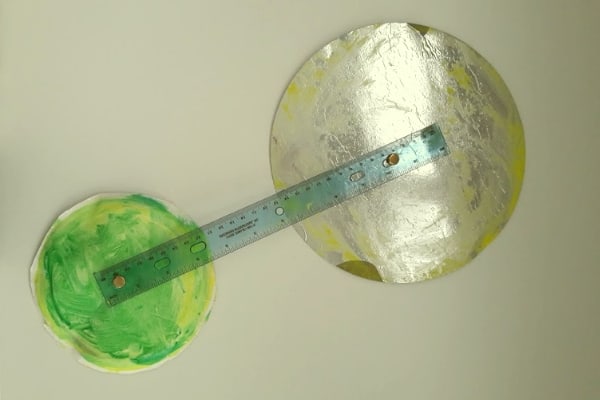 Alternatively they can use the Earth they painted in Lesson 1.
Alternatively they can use the Earth they painted in Lesson 1.
Lesson 4
Discuss the four seasons.
Recap that the Earth Orbits around the Sun. Recap the Earth spins. Ask how long it takes for the Earth to spin once -24 hours, and How long it takes to Orbit once around the sun – 1 year.
Explain that as the Earth orbits around the sun, because of its TILT, we get the seasons. Show with your globe when is summer -the globe with the northern hemisphere tilted towards the sun; and when is winter on the oposite side of the orbit and the globe with the northern hemisphere tilted away from the sun.
Show spring and fall.
Play a game based on this concept: One person stands in the middle of the room, she’s the sun, the other spins, and moves to a season based on what the sun calls out.
Lesson 5
They should be able to answer by now: What does the Earth do? How long does it take for the Earth to spin once? How do we get day and night?
Why does it spin? Let them know that the Earth has a hot liquid metal that makes it spin.
Recap seasons and the Earth Rotation and Orbit.
Re-cap of the Earth orbiting around the Sun, the seasons and the tilt of the Earth.
Ask them to show you with the globe how is the Earth position right now. Pretend you or an object in the room is the sun.
Core Lesson: Learn the days of the week. Sing the days of the week song.
Count the days of the week.
Lesson 6 – Winter Solstice Party
Invite friends to a Winter Solstice Party Of Snacks, Crafts and Winter Celebration
Ask them to talk about stars, and if they know any planets. Ask which planets they know about (they probably know more than you!)
Today we are going to think about planets.
Who knows what are planets? (Gather all kinds of answers).
The one we are going to think about today is Earth. Why is Earth special? (Gather all kinds of answers).
Earth also spins all the time. It spins on it’s Axis. Not only that but at the same time…And it goes around the sun!
Explain that the Winter Solstice marks the shortest day of the year and the longest night of the year. But after today, the days will start getting a little longer everyday.
That is what we celebrate today. The shortest day of the year!
Talk about the Northern and Southern Hemispheres.
Sit in a circle and pass the globe around, stop when is winter solstice.
Craft / Activity
Make a candle that kids can take home. This signifies the sun going down early and the candle lighting up our evening. However, you don’t need to burn the candle on this day, it’s just a symbol.
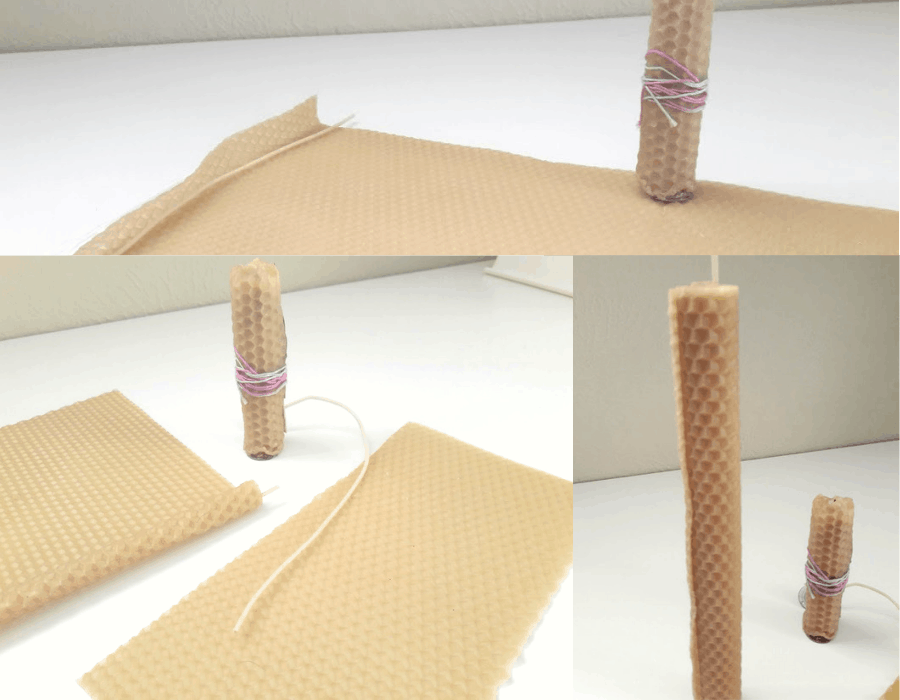
You can get the was and wick online or at a local candle craft store or honey supplier. One sheet of wax can easily cut and make at least four smaller candlers.
Another craft I like to do for Winter Solstice Party is Sun Catcher Planets and The Potpourri Pouches, both of which you can find in this post here.
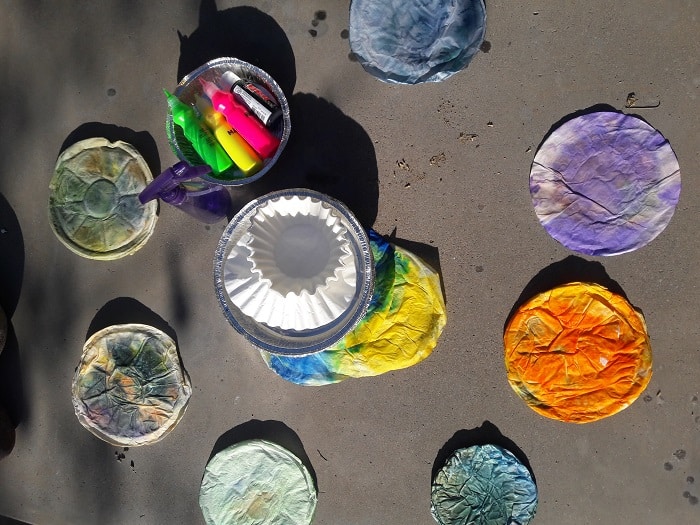
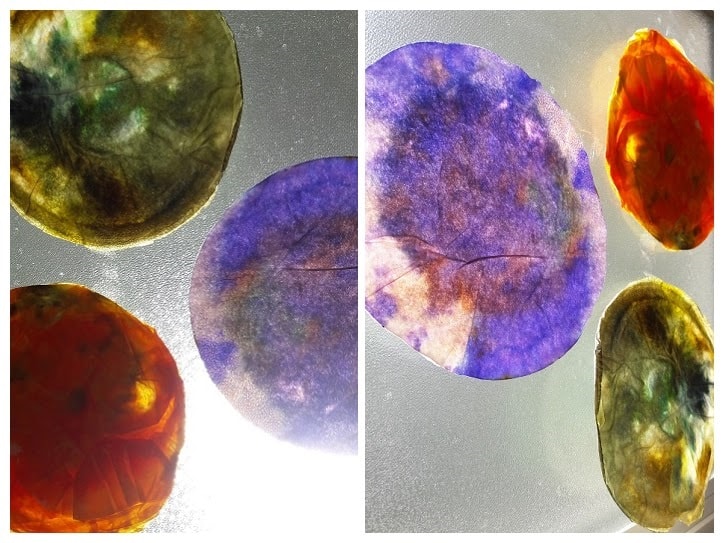
You can have this party or a slight variation every year and make it a tradition. Aim at your child taking on the part of explaining to other kids how the Earth orbits and shows the tilt of the Earth correctly.
Lesson 7
Core lesson: Have your child take the globe and look at the lines on it. Point out the top half is the Northern Hemisphere…at the top is the North Pole. The bottom half is the Southern Hemisphere, the point at the bottom is the South Pole. Point out the meridians, the longitude and latitude lines.
Lesson 8
Recap: where is the North Pole? Where is the South Pole? What do we call the top and bottom halves of the Earth? What do we call these lines?
Core lesson: The Solar System. Talk about stars, planets, moons.
Explain in simple terms gravity and that the moon is responsible for it. Explain tides (optional)
Vocabulary word: Gravity.
Craft/project
Work with different materials to create a model of the solar system.
Make lunch, eat together.
Lesson 9
Spring
After the winter…days got longer and in the spring plants get more sun and water. So they start to go into bloom.
Talk about Pollination:
Ask them what do they think is the most important job? Doctors? Police? The president? Surprise them with this answer: BEES! They are Pollinators. Without them, we would’ve have most food we eat…
When bees go looking for nectar to make honey, they go from flower to flower and the powdery pollen gets on their legs and their whole body, when they go on to the next flower so of the pollen falls off. They do that all day long during the spring, and that is how flowers turn into fruits or veggies.
So bees have the most important job in the world! Pollination!
Vocabulary word: Pollination
Craft/activity
Go on a nature walk and collect elements to Make art with nature (link).
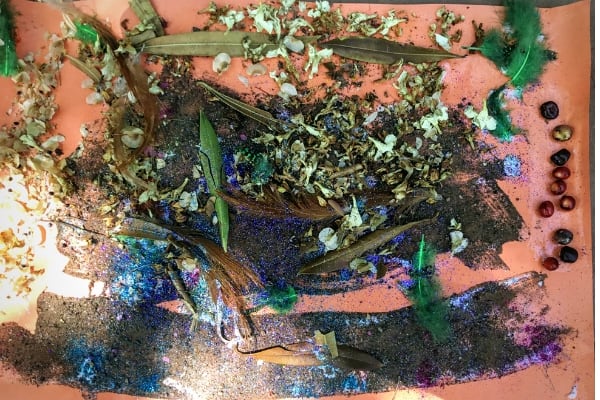 Or check out this post for a lot of other nature-based activities kids love.
Or check out this post for a lot of other nature-based activities kids love.
Pay attention to other pollinators like butterflies, moths, hummingbirds…Make spring lunch together.
Lesson 10
Summer
Summer Solstice is the longest day of the year. The Earth is tilting towards the sun in our hemisphere so we are getting more light, that is why night time comes latter in the summer.
Ask what vegetable and fruits grow in the Summer? Peaches, cucumber, avocados, tomatoes, watermelon!
Make lunch together and have your child help make a seasonal fruit dish or salad.
Craft / Activity
Make a Sun catcher craft (link to Art and Crafts) of the Earth, the Sun, or any imaginary or real planet.
Lesson 11 – Exhibit, so plan and invite ahead.
Fall
When you do fall crafts, fall foods, buy a pumpkin, etc, talk about where the Earth is in relation to the sun.
Learn the Months of the Year
Activity – Exhibit
Prepare Exhibition of all the projects and artwork you’ve made so far. Invite family and friends. Offer seasonal snacks.
Lesson 12
Winter (when you do to this lesson your child should be at least 6 years old.)
Make a calendar together.
Help your child number the days and mark all the relevant dates by making little drawings, or putting stickers or writing a note.
Count all the days. Ask how many days are there?
Dec 31st is the last day of December. It is also the last the last day of the Year!
Talk about how many days are there in one month.
Craft/Project
Make an advent calendar with treats. We make them to celebrate the end of the year.
Take some paper towel cylinders and cut them in pieces about 1.5 to 2 inches. Kids can do this easily. 31 total. Alternatively, use tiny paper cups.
Hot glue them on a cardboard.
Ask your child that he needs to gather 31 pieces of candy (maybe some left from Halloween) to insert into the cylinders. And he also needs to cut out 31 pieces of tissue paper and write the numbers from 1 – 31.
Once the candy is inside he has to glue the tissue on each cylinder.
It’s ok if the numbers are backwards as long as they can sort them in order.
Swap some of the candy for trinkets and new treats so they are surprised when they punch the hole through to get the candy each day.
Lesson 13
Recap: The days of the week. How long is a day? How many days are there?
Recap: The months of the year. How many months are there? How many days in one month?
Recap: The names of the seasons.
Activity
Make some winter paintings during this time.
If they are at least 7, show them how to draw a sphere with shading to give it dimension and make it very light on the side where the sun would be.
Lesson 14
Core lesson: recap the hemispheres, the poles. Talk about Continents.
Point out that the Earth is composed of continents and oceans.
The blue is the oceans. Ask the child to point and touch all the oceans and seas he sees.
Point to the continents. Explain that there are 7 continents, and point to them as you move the globe: Europe, America (south and north), Asia, Australia, Oceania, and Antartica.
So what are the continents? They are big chunks of the world full of countries. Let;scpoint to where we live. Can you find it? What continent do we live on?
Let’s point at some countries.
Activity/craft
Make a map. It could be a made up map or a real map of a place or the Earth with the continents and the oceans.
Lesson 15
The weather.
Talk about how the clouds form. Explain that in the summer the continents get very hot and the oceans that are so big and cold take a long time to warm up. So the heat pulls the moisture from the oceans and it forms heavy cumulus clouds that let their water out.
In the winter, when the continents have cooled down, the oceans are a bit warmer and the same thing happens. This is how we get weather fronts.
The Sun, the Earths orbit, the continents and the oceans all act together to get our seasons, our weather, photosynthesis and food.
Activity
Make water vapor and demonstrate how rain is formed.
Lesson 16
Recap continents.
Recap oceans. Point out the oceans.
Recap how we get weather. How rain is formed.
Core lesson: Learn about the sky: atmosphere, and stratosphere.
Learn about the types of clouds.
Activity
Make a painting with the types of clouds, and weather.
Lesson 17
Go back to lessons 1 and 2. Make craft of earth orbiting and spinning.
These concepts and the vocabulary that goes along with it can be forgotten if you only do these lessons once.
Go back and do part of the lessons again such as variations of the crafts.
You may also enjoy incorporating these in your Homeschool:
Project Based Homeschooling – With tons of project ideas
Best Math and How to Help Your Child Learn It
Unschooling Cooking – A Class Guide to develop a love for food and cooking.
